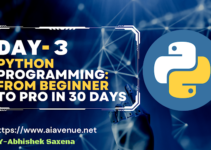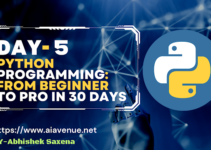 |
| Python Programming Day-4 |
Day 4: Control Structures – Part 1
Table of Contents:
- Decision-making structures: if-else statements
- Nested if-else statements
- Switch-case statements
- Example codes
In programming, control structures are used to control the flow of execution of the program. These structures help in making decisions and controlling the sequence of instructions executed in a program. In this chapter, we will discuss some commonly used decision-making structures: if-else statements, nested if-else statements, and switch-case statements.
Decision-making structures: if-else statements
The if-else statement is a basic decision-making structure in programming. It is used to execute a block of code based on a condition. The basic syntax of an if-else statement is as follows:
 |
In the above code, the condition is evaluated, and if it is true, the code inside the first block is executed. If the condition is false, the code inside the second block is executed.
Example:
Output: x is greater than 5
In this example, the condition “x > 5” is true, so the code inside the if block is executed.
Nested if-else statements
In programming, it is sometimes necessary to use multiple if-else statements together. This is called a nested if-else statement. The basic syntax of a nested if-else statement is as follows:
In the above code, the first if statement is evaluated, and if it is true, the code inside the first block is executed. If the first condition is false, the code inside the else block is executed. If the first condition is true and the second condition is also true, the code inside the nested if block is executed. If the first condition is true and the second condition is false, the code inside the else block of the nested if statement is executed.
Read More: https://aiavenue.net/2023/04/14/day-5-python-programming-from-beginner-to-pro-in-30-days/
Example:
Output: x is greater than 5 and y is greater than 3
In this example, the first condition “x > 5” is true, so the nested if statement is executed. The second condition “y > 3” is also true, so the code inside the nested if block is executed.
Switch-case statements
The switch-case statement is another decision-making structure in programming. It is used when there are multiple conditions to be checked against a single variable. The basic syntax of a switch-case statement is as follows:
// code to be executed if none of the cases match the variable
}
In the above code, the variable is evaluated against each case value. If the variable matches a case value, the code inside that case block is executed. The break statement is used to exit the switch-case statement once the code inside a case block is executed.
“Take Your Python Skills to the Next Level with Functions – Day 5” – Read more here: https://aiavenue.net/2023/04/14/day-5-python-programming-from-beginner-to-pro-in-30-days/
Example:
Output: Wednesday
In this example, the variable “day” is evaluated against each case value. Since the value of “day” is 3, the code inside the third case block is executed, which prints “Wednesday”.
In conclusion, control structures are an essential part of programming that allows developers to execute specific code based on certain conditions. These structures help to control the flow of execution of a program, and there are several types of control structures available.
The most basic decision-making structure is the if-else statement, which allows developers to execute different code blocks based on a true or false condition. This structure is particularly useful when there are only two possible outcomes to a condition. However, when there are more than two possible outcomes, the switch-case statement can be used instead.
The switch-case statement is particularly useful when there are several possible outcomes for a condition. The switch statement evaluates a variable against each case value and executes the code inside the corresponding case block. The break statement is used to exit the switch statement once the code inside a case block is executed. The default case can be used to execute code if none of the case values match the variable.
Nested if-else statements can also be used to execute code based on multiple conditions. In this structure, if-else statements are nested inside each other to execute code based on multiple conditions. However, nested if-else statements can quickly become confusing and difficult to read, especially when there are several conditions to be checked.
Boolean expressions can also be used in decision-making structures to evaluate a condition as true or false. A Boolean expression is a statement that evaluates to true or false, such as (x > y).
Overall, control structures are an essential tool for programming, and it’s important for developers to understand the syntax and usage of each structure. Developers should choose the appropriate control structure for each situation to ensure the code is efficient, readable, and easy to maintain.
Some tips for using control structures effectively include keeping the code simple, avoiding nested structures when possible, and using comments to explain the purpose of the code. Additionally, developers should test their code thoroughly to ensure that the control structures are working correctly and the code is executing as intended.
In conclusion, control structures are an essential part of programming that allows developers to execute specific code based on certain conditions. Whether using if-else statements, switch-case statements, or nested if-else statements, it’s important to understand the syntax and usage of each structure to write efficient, readable, and maintainable code. By following best practices and testing their code thoroughly, developers can ensure that their control structures are working correctly and their code is executing as intended.
“Take Your Python Skills to the Next Level with Functions – Day 5” – Read more here: https://aiavenue.net/2023/04/14/day-5-python-programming-from-beginner-to-pro-in-30-days/







